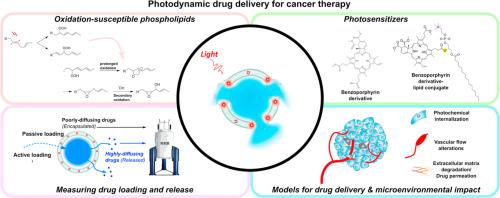癌症治疗的光动力给药:设计光控释放脂质体和提高药物疗效。
IF 4.7
3区 医学
Q1 PHARMACOLOGY & PHARMACY
引用次数: 0
摘要
光动力学涉及光催化化合物的使用,这些化合物在光激发下产生活性氧,并以光动力疗法的形式在癌症治疗中得到广泛应用。在药物传递领域,光动力学已经成为一种非常有效的方法,通过利用光化学氧化还原反应来破坏含有氧化敏感赋形剂的脂质纳米配方的时空控制药物释放。尽管在临床前模型中非常有希望的结果,但这种控制释放方式尚未在临床癌症试验中进行探索。这篇综述概述了光动力药物递送中脂质纳米制剂的关键设计考虑因素,重点是它们对光化学氧化还原反应的敏感性,它们诱导溶酶体渗透的能力,以及促进微环境启动增强肿瘤渗透性的能力。这些考虑首先强调了特定脂质赋形剂在确定光动力药物释放效率中的作用。其次,考虑了光敏剂的选择,理想的光敏剂吸收bb0 650nm的光,并表现出有限的浸出。第三,选择的光敏剂和药品货物可能决定了应该采用哪种药物装载方法,以及如何检测药物释放。我们特别强调核磁共振(NMR)光谱学的前景,因为它可以提供封装和释放的药物货物的非破坏性定量,以及脂质纳米配方的结构评估,而无需事先分离或复杂的样品制备。最后,考虑到光动力学对癌细胞和癌症微环境的必然影响,我们强调了多模型方法评估新型光动力学给药系统的实用性。通过提供这些设计考虑,本文综述旨在促进光动力给药领域的发展,并鼓励其在转化性癌症研究中的应用。此外,这些方面同样与刺激研究有关,以替代外部刺激触发氧化反应性药物释放,从而扩大抗癌药物输送库。本文章由计算机程序翻译,如有差异,请以英文原文为准。

Photodynamic drug delivery for cancer therapy: Designing liposomes for light-controlled release and enhanced drug efficacy
Photodynamics involves the use of photocatalytic compounds that, upon excitation with light, produce reactive oxygen species and have seen widespread applications in the treatment of cancer in the form of photodynamic therapy. Within the field of drug delivery, photodynamics has emerged as a strikingly effective approach for spatiotemporal-controlled drug release by harnessing photochemical redox reactions to destabilize lipid nanoformulations that contain oxidation-susceptible excipients. Despite highly promising outcomes in preclinical models, such controlled release modalities have not yet been explored in clinical cancer trials. This review outlines key design considerations for lipid nanoformulations in photodynamic drug delivery, focusing on their susceptibility to photochemical redox reactions, their ability to induce lysosomal permeabilization, and facilitate microenvironmental priming that enhances tumor permeability. These considerations first highlight the role of specific lipid excipients in determining photodynamic drug release efficiencies. Secondly, the selection of the photosensitizing agents is considered, which ideally absorb light >650 nm and exhibit limited leaching. Thirdly, the selected photosensitizing agent and pharmaceutical cargoes may dictate which drug loading approach should be pursued, and how drug release is detected. We particularly highlight the promise of nuclear magnetic resonance (NMR) spectroscopy as it can provide non-destructive quantification of encapsulated and released pharmaceutical cargoes, alongside structural assessments of the lipid nanoformulations, without the need for prior separation or complex sample preparation. Finally, considering the corollary effects of photodynamics on cancer cells and the cancer microenvironment, we emphasize the utility of a multi-model approach to evaluate novel photodynamic drug delivery systems. By providing these design considerations, this review aims to boost the field of photodynamic drug delivery and encourage its exploitation in translational cancer research. Moreover, these aspects are equally relevant to stimulate investigations towards oxidation-responsive drug release triggered by alternative external stimuli, thereby broadening the drug delivery arsenal against cancer.
求助全文
通过发布文献求助,成功后即可免费获取论文全文。
去求助
来源期刊
CiteScore
9.60
自引率
2.20%
发文量
248
审稿时长
50 days
期刊介绍:
The journal publishes research articles, review articles and scientific commentaries on all aspects of the pharmaceutical sciences with emphasis on conceptual novelty and scientific quality. The Editors welcome articles in this multidisciplinary field, with a focus on topics relevant for drug discovery and development.
More specifically, the Journal publishes reports on medicinal chemistry, pharmacology, drug absorption and metabolism, pharmacokinetics and pharmacodynamics, pharmaceutical and biomedical analysis, drug delivery (including gene delivery), drug targeting, pharmaceutical technology, pharmaceutical biotechnology and clinical drug evaluation. The journal will typically not give priority to manuscripts focusing primarily on organic synthesis, natural products, adaptation of analytical approaches, or discussions pertaining to drug policy making.
Scientific commentaries and review articles are generally by invitation only or by consent of the Editors. Proceedings of scientific meetings may be published as special issues or supplements to the Journal.

 求助内容:
求助内容: 应助结果提醒方式:
应助结果提醒方式:


